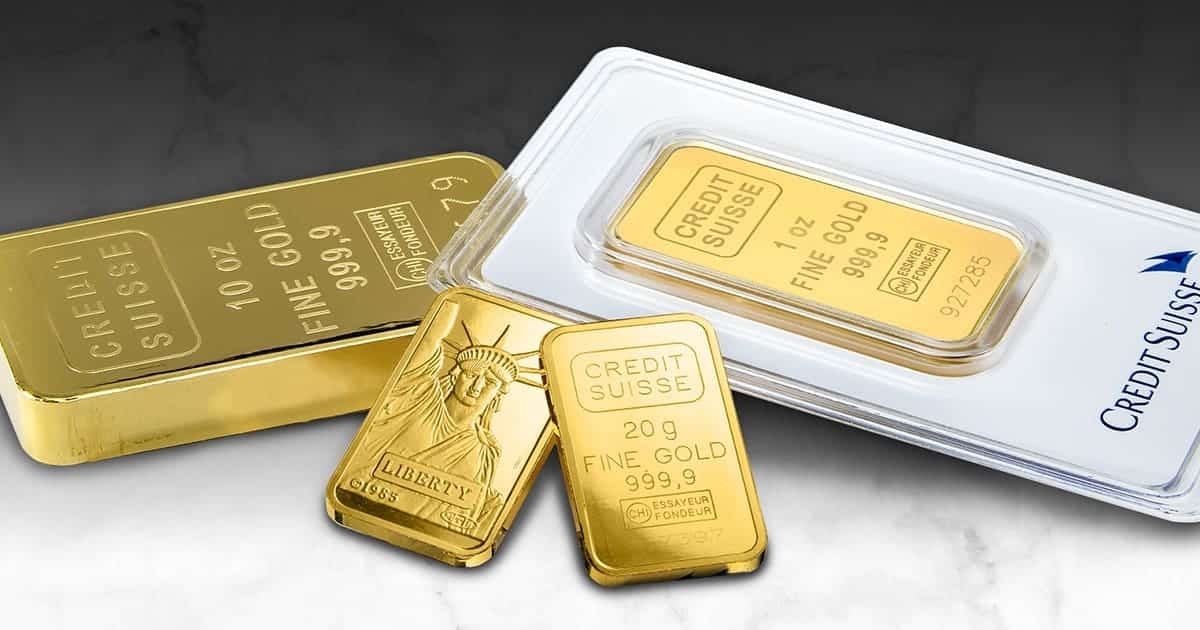
If you have not held a gold bar in your hand, it may be difficult to imagine the density and weight of a gold bar. Gold is dense—one of the densest metals on earth at 19.32 grams per cubic centimeter. One troy ounce of .9999 gold in bar form may be as small as 1.6mm (about 0.06 in) thick.
When people think about gold, they often think about the large gold bricks they see in movies. But the average person can rarely afford that amount of gold, and it is more difficult to sell than smaller bar sizes. Just one kilogram of gold is nearly $80K as of May 2024. It is more common for middle-income people to buy gold by the ounce.
Common Sizes and Weights of Gold Bars
Gold bars come in various weights to accommodate different types of investors, from those making small investments to institutional buyers. The weight of a gold bar is often measured in troy ounces, grams, or kilograms.
| Bar Size | Weight (Pounds) | Comparision Weight |
| One Gram | .00220462 | A Toothpick |
| Five Grams | 0.1102311 | A Nickel |
| One Half Troy Ounce | 0.3428571 | Three Quarters |
| Ten Ounces | .625 | A Roll of Toilet Paper |
| One Troy Ounce | 0.6857143 | Six Quarters |
| 500 Grams | 1.10231131 | A Loaf of Bread |
| One Kilogram | 2.2046226 | One Basketball |
| 100 Troy Ounces | 6.85714286 | A Blender |
| 400 Troy Ounces | 27.4285714 | About Three Gallons of Water |
Here are the most common weights:
- 1 Gram: Small and affordable, ideal for first-time investors or those looking to gift gold.
- 5 Grams: Slightly larger, manageable, and often bought in small quantities.
- 10 Grams: A popular choice for moderate investments.
- 1 Ounce: One of the most common weights, favored by serious investors for its balance of size and value.
- 50 Grams: A larger bar that offers good value for those looking to invest more substantially.
- 100 Grams: A common weight for more significant investments, offering a lower premium per gram.
- 1 Kilogram: Preferred by institutional investors, these bars are substantial and offer economies of scale.
- 400 Ounces: Known as “Good Delivery” bars, these are used in international trade and by central banks.
Each size has its advantages, from the flexibility of smaller bars to the investment efficiency of larger ones.
Best Size of Gold Bars to Buy
The best size of gold bar to buy depends on your investment goals, budget, and storage preferences.
Here are key considerations for different sizes of gold bars:
Small Bars (1 gram to 10 grams)
Advantages:
- Affordability: These are accessible for new investors or those with a limited budget.
- Flexibility: Easy to sell or trade in small increments.
- Gift Potential: Ideal for gifts or small savings plans.
Disadvantages:
- Higher Premiums: Smaller bars typically have higher premiums per gram due to manufacturing costs.
Medium Bars (1 ounce to 100 grams)
Advantages:
- Popular Size: 1-ounce bars are widely recognized and easier to trade.
- Balance: Offers a good balance between premium costs and affordability.
- Liquidity: Still relatively easy to sell when needed.
Disadvantages:
- Moderate Premiums: While lower than small bars, premiums are still higher than large bars.
Large Bars (1 kilogram and above)
Advantages:
- Lower Premiums: Larger bars generally have lower premiums per gram, making them cost-effective.
- Investment Efficiency: Ideal for significant investments, providing more gold for your money.
- Storage Efficiency: Fewer bars mean less storage space required.
Disadvantages:
- Higher Cost: Requires a substantial upfront investment.
- Less Liquidity: Can be harder to sell in smaller portions.
Considerations for Choosing the Best Size
- Investment Amount: Match the bar size to your budget and how much you plan to invest.
- Liquidity Needs: Consider how quickly you may need to sell your gold. Smaller bars offer greater flexibility.
- Storage and Security: Ensure you have a secure place to store your gold. Larger bars require less space but can be harder to sell in small quantities.
- Market Recognition: Bars from well-known mints and refiners are easier to sell.
Popular Choices
- 1 Ounce Bars: Highly favored for their balance of cost, liquidity, and ease of storage.
- 100 Gram Bars: Popular among more serious investors for their lower premiums per gram.
- 1 Kilogram Bars: Preferred by institutional investors for significant savings on premiums.




